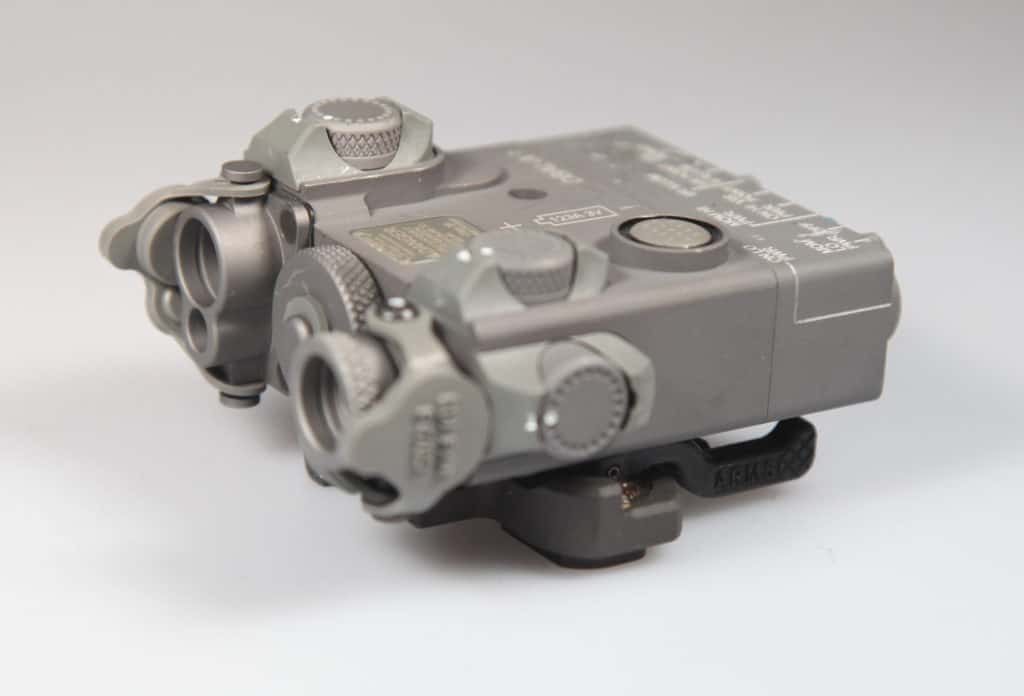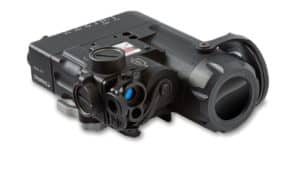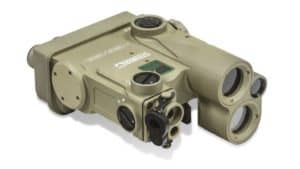In this article we’ll take a close look at Dual Beam Aiming Lasers (DBAL), such as those from Steiner Defense.
First of all – what is a Dual Beam Aiming Laser?
It’s a laser pointing device that contains both a day-light visible red or green laser combined with a co-aligned Infrared (IR) laser that is visible only with night vision.
These are also often called multi-function aiming lights.
It’s a laser pointer that works in both day and night.
Being that the two lasers are “co-aligned” means when you zero with the day laser; the IR laser will be spot-on as well.
Here’s the products we are going to look at.
DBAL-A2 – the AN/PEQ-15A Advanced Target Pointer Illuminator Aiming Light
The story of the DBAL line starts with the AN/PEQ-15A.
This is latest version of a Advanced Target Pointer Illuminator Aiming Light (ATPIAL) fielded by the US Army.

Ok, that acronym is a mouthful.
Let’s talk about what one of these devices is – and why you’d want (or need) one.
First of all, “Dual Beam” gives away a lot.
These devices typically include two precise aiming lasers.
An aiming laser is used to allow someone to shoot rapidly and accurately.
Further, one laser is visible in daylight, and the other is an invisible laser that uses Infrared light wavelengths.
What good is it if it’s invisible?
It’s easily visible using Image Intensification (II or I2) night vision devices.
And that includes night vision goggles like the AN/PVS-7 or AN/PVS-14, or more advanced devices.
Night vision devices can easily “see” these infrared light waves.

Having a visible laser also means you can shoot without a “cheek weld” – meaning when you are unable to put your face right up against the stock of the weapon and look down the sights.
Why would you need to do this? Perhaps you are wearing a gas mask – or shooting from a very unusual position to maximize your use of cover.
The visible laser is available in both red and green colors. Green is more visible to the un-aided human eye, as compared to red.
Additionally, most of these devices also include an IR illuminator.
This is used to further improve the view when using night vision devices.
This is a wide beam of infrared light (usually accomplished via a laser with diffuser) to supplement any sources of ambient light.
Lastly, the two lasers are “co-aligned”. This means you can easily zero in the weapon using the day laser – and you can be sure the invisible IR laser will also be dialed in.
(Imagine the logistics and difficulty of having to zero in both day and darkness conditions!)
As with all things technology – there are improved versions of the Dual Beam Aiming Laser – and we’ll look at those next.
DBAL-A3
Features an adjustable IR illuminator for better illumination at longer ranges, dual activation switches, and high/low power modes. Provides a “visible override” port to integrate a white light LED with the visible laser.

DBAL-A4
The DBAL-A4 has all that good stuff plus a white light illuminator – which is a 400+ Lumen LED tactical light.
New Advanced DBAL-A4 with four functions: visible laser, IR laser, IR illuminators, and white light illuminator. High/low modes. Restricted and commercial models available.
- Spot and Wide Field of View (Flood)
- IR Illumination Modes
- Fully adjustable windage and elevation
- Available in low power and restricted- military configurations
- Integrated push-button switch and remote cable pressure-pad switch activation – tap and release for momentary activation; tap twice for 5-minute continuous ON
- Attaches to any Picatinny rail using secure quick disconnect mount
- Includes remote cable ports for paddle switch activation and visible Laser/White Light override
DBAL-D2
The D2 is meant for longer range IR illumination.
It has an adjustable focus ring on the IR illuminator.

Manufactured with high definition, aspherical telescopic lens technology, the DBAL-D2 features a 2° to 30° adjustable illumination beam.
This highly collimated beam significantly enhances night vision performance and offers an eye-safe means of illuminating distances greater than 1000 m. Military and law enforcement models also features an enhanced end cap, taking full advantage of the added switching capabilities of the full powered D2.
DBAL-I2 – Dual Beam Aiming Laser – Intelligent2
The most lightweight model in the DBAL Series, this “intelligent” laser provides extreme accuracy in low- light conditions and can be used with night-vision devices.

Pre-drilled mounting holes for optional sub-miniature red dot or mil-spec top rail.
DBAL-PL – for pistols
Here’s all that good stuff in a pistol friendly form factor (and weight.)

The Steiner eOptics pistol light laser series enables operators to engage targets on a battlefield or during close-quarter combat in low-light and no-light conditions.

The DBAL-PL is fully programmable and dimmable in both visible and IR modes
Program single tap, double tap, and press and hold functions and control the dimming level of each.
- Red or Green visible aiming laser, IR laser, IR illuminator & white light
- Co-aligned visible & IR aiming Lasers
- Fully adjustable windage and elevation
- Integrated adjustable Picatinny mount
- Powered by two CR123A Batteries
- Quick-release battery latches
- Available in Green (79050) and Red (79040) Lasers
- Bright white light and IR illuminator sits below the laser pointers
- Recoil resistant design ensures reliable performance
DBAL-RL
This is like the -PL model, but made for rifles, carbines, and shotguns.

The DBAL-RL is similar in functionality to the DBAL-PL, with the added benefit of a single receptacle end cap for remote switch operation. This makes the DBAL-RL perfect for the unique requirements presented in Close Quarter Battle (CQB) environments where the use of a shotgun or short-barrel rifle is mandatory.
Dual Beam Aiming Lasers – In Summary
Dual Beam Aiming Lasers are versatile devices – for those that need to shoot accurately day or night.
They are called “dual beam” because they include a visible day laser and an invisible night laser.
All include an IR illuminator.
Some models include a bright white tactical light too.
References
Photo Credits
The appearance of U.S. Department of Defense (DoD) visual information does not imply or constitute DoD endorsement.
Much of the photos in this article are provided by the U.S. Department of Defense (DoD), or the manufacturers – and are the property of the manufacturers.
Affiliate disclaimer
We are an affiliate of OpticsPlanet.com and this article contains affiliate links. If you purchase equipment after clicking through these links, we receive a small commission at no additional cost to you. This helps us to bring you great information about this technology.









